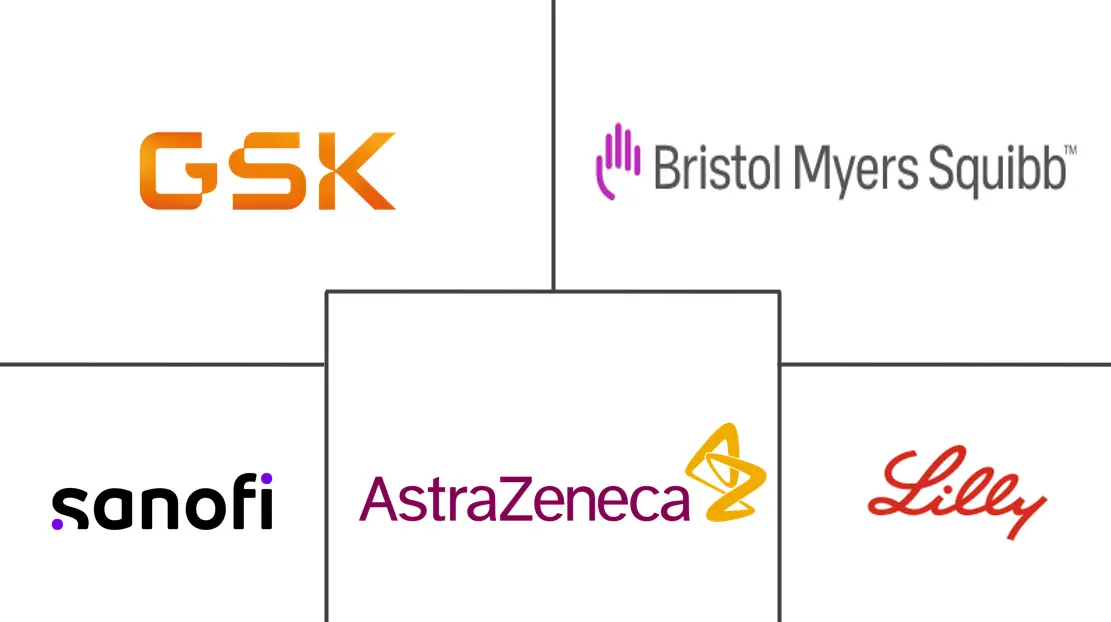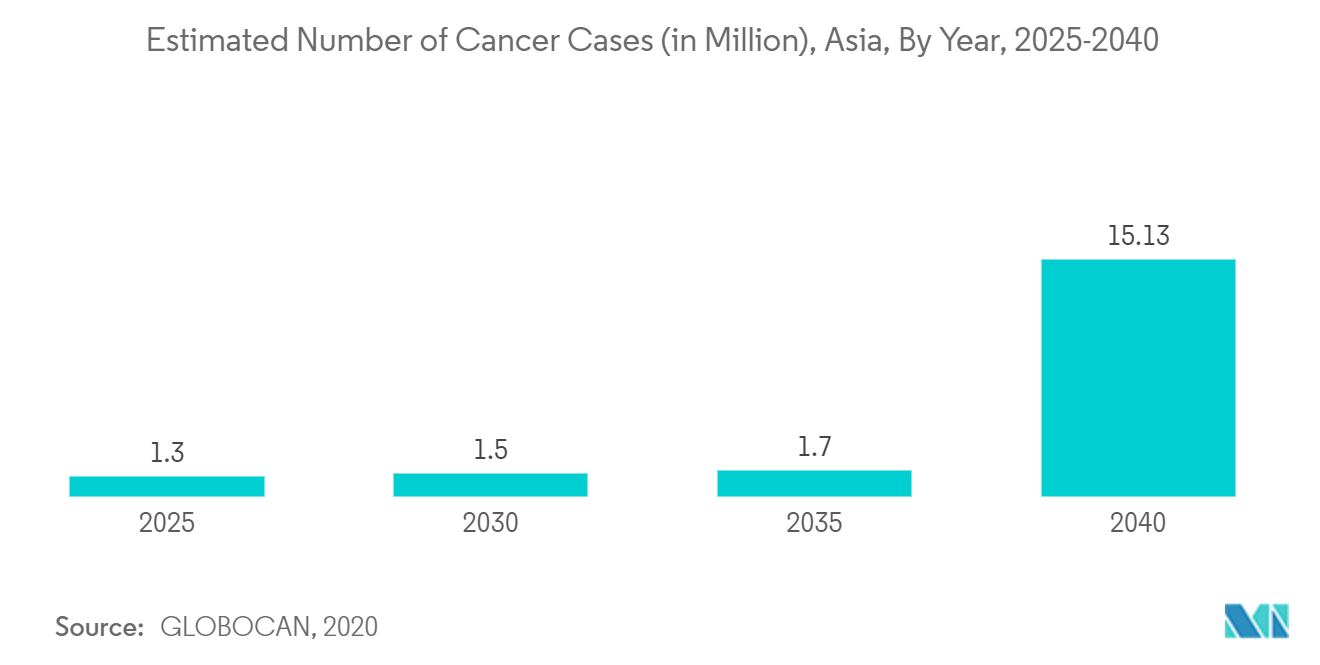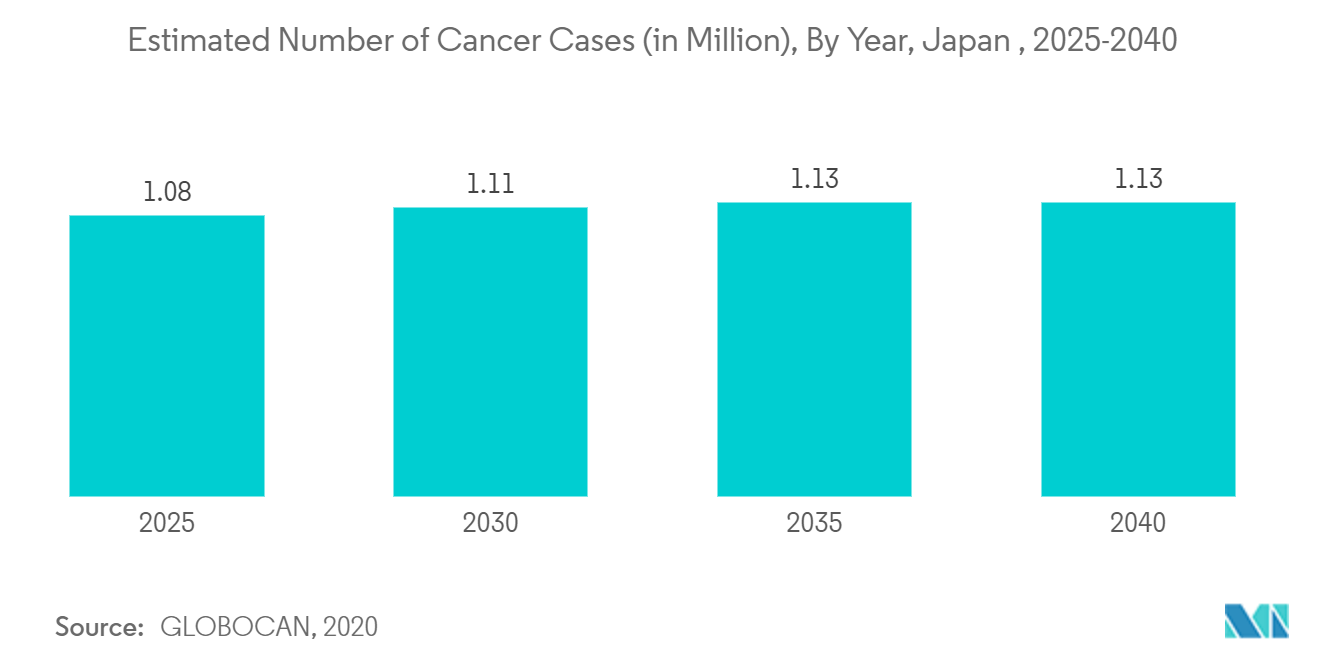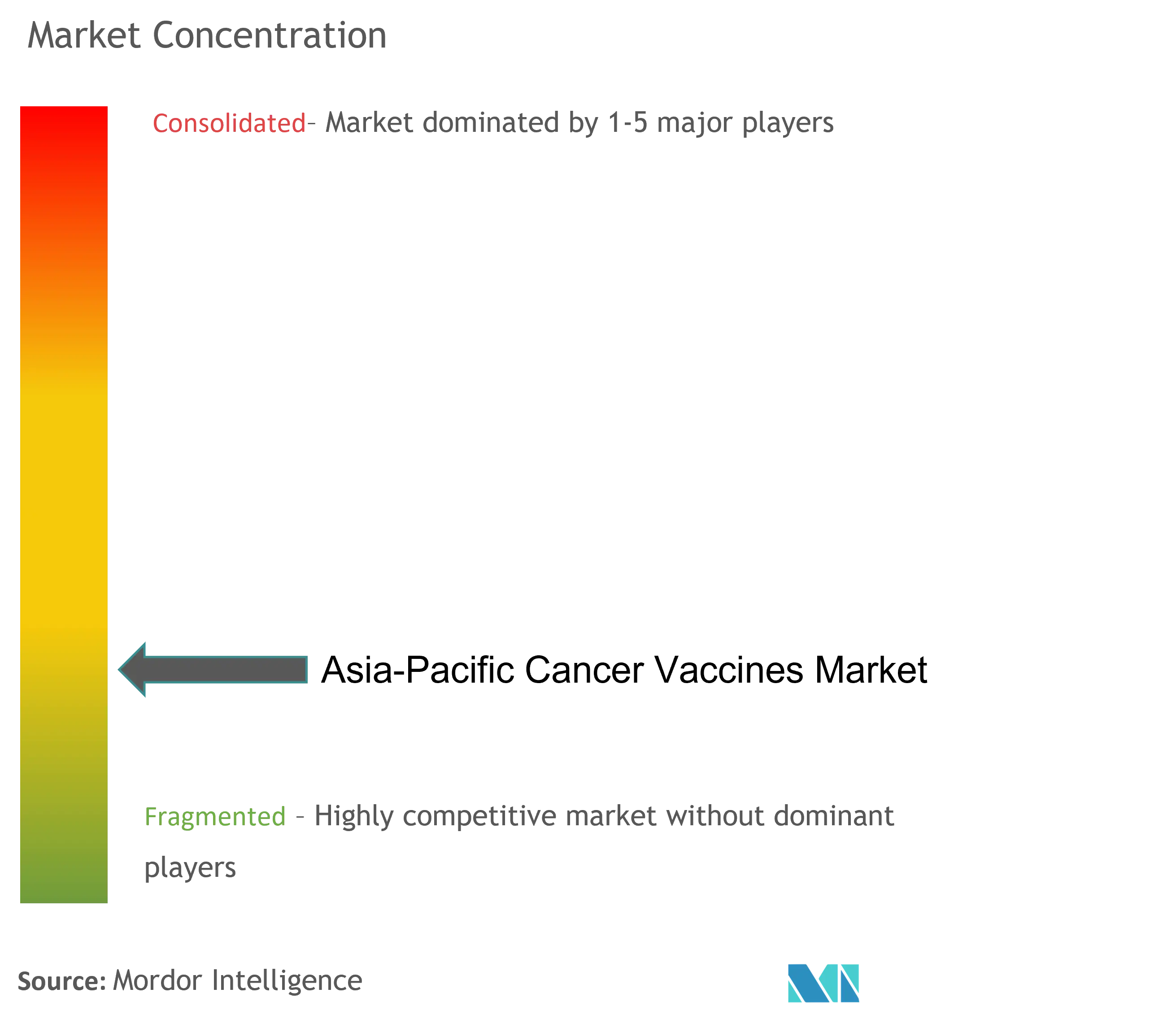Asia-Pacific Cancer Vaccines Market Size

| Study Period | 2019-2029 |
| Base Year For Estimation | 2023 |
| Market Size (2024) | USD 2.34 Billion |
| Market Size (2029) | USD 4.06 Billion |
| CAGR (2024 - 2029) | 11.55 % |
| Market Concentration | Low |
Major Players
*Disclaimer: Major Players sorted in no particular order |
Asia-Pacific Cancer Vaccines Market Analysis
The Asia-Pacific Cancer Vaccines Market size is estimated at USD 2.34 billion in 2024, and is expected to reach USD 4.06 billion by 2029, growing at a CAGR of 11.55% during the forecast period (2024-2029).
The COVID-19 pandemic impacted the growth of the Asia-Pacific cancer vaccines market. For instance, an article published by the National Cancer Institute in January 2022 reported that stunning results were obtained on developing mRNA COVID-19 vaccines that led the researchers to the development of mRNA-based cancer treatment vaccines. The article also reported that dozens of clinical trials were testing mRNA treatment vaccines in people with various types of cancer, including pancreatic cancer, colorectal cancer, and melanoma. Thus, COVID-19 had a significant impact on the growth of the studied market. In the current scenario, it is anticipated that due to advancements in technology and the commencement of various clinical trials, the studied market is expected to witness significant growth over the forecast period.
The factors that are driving the growth of the studied market are the growing burden of cancer, emphasis on early diagnosis of cancer, and technological developments in cancer vaccines. An article published by the journal BMC Cancer in May 2022 reported that the cancer burden has shown a steady increase in India, with an estimated 0.8 million new cancer cases every year. By 2040, nearly 2 million new cancer cases are expected in India. Similarly, another article published by the National Centre for Biotechnology Information (NCBI) in April 2022 reported that, in total, 274,488 new cancer cases were expected to occur in Korea in 2022. Thus, such instances provide insights into an increased demand for cancer vaccines in the country, thereby contributing to the studied market’s growth.
The emphasis on early cancer diagnosis in the region is expected to contribute to the studied market. For instance, an article published by Cancer Biology and Medicine in April 2022 reported that the Chinese government had initiated early screening for breast cancer mainly relies on imaging techniques, most importantly mammography, ultrasound (US), and magnetic resonance imaging (MRI) in many hospitals in the year 2021 for the financially weaker section of the society. The early detection of cancer may lead to early cancer treatment, which may increase the demand for cancer vaccines in the country.
Furthermore, the new vaccine launch may lead to better cancer treatment, thereby contributing to the studied market. For instance, in August 2022, A recent study found that China’s first self-developed HPV vaccine, Cecolin, can offer female adults full immunity against the human papillomavirus (HPV). A group of Chinese researchers analyzed data from 66-month follow-up visits as part of the bivalent vaccine’s Phase 3 clinical trial. The efficacy of this vaccine against high-grade genital lesions, typical symptoms of cervical cancer, reached 100 percent. Thus, such studies are driving the studied market growth.
Thus, the growing burden of cancer, emphasis on early diagnosis of cancer, and technological developments in cancer vaccines may drive the growth of the studied market. However, the presence of alternative therapies may slow down the studied market growth.
Asia-Pacific Cancer Vaccines Market Trends
Preventive Vaccines is Expected to Show Better Growth Over the Forecast Period.
Preventive vaccines or prophylactic vaccines are vaccines intended to prevent cancer in healthy people. These vaccines work by preventing infectious agents that cause or contribute to the development of cancer. These vaccines are similar to traditional vaccines that help prevent infectious diseases, such as polio and measles, by protecting the body against infections. Most preventive vaccines stimulate the production of antibodies, which bind to specifically targeted microbes and block their ability to cause infection.
Also, the initiative to control cancer cases by providing early diagnosis is driving the growth of this segment. For instance, in January 2022, the Healthy China Action Plan updated its norms for further specified objectives and strategies for gradually improving screening coverage of cervical cancer, promoting Human Papillomavirus (HPV) vaccination, and improving the accessibility of HPV vaccines by 2030 in China.
Hence, owing to these factors, along with the rising burden of cancer, the market is expected to witness significant growth over the forecast period.

Japan is Expected to Witness High Growth Over the Forecast Period.
Japan is expected to witness high growth over the forecast period owing to the high number of cancer cases, clinical trials for cancer vaccines launched, and emphasis on early cancer diagnosis. The growing number of cancer cases is expected to drive the growth of the studied market in Japan. For instance, Globocan reported that 1.078 million cancer cases were recorded in Japan in the year 2025, and this number is expected to increase to 1.110 million by 2030 and by 1.128 million by 2040. thus, rising cancer cases are expected to drive the growth of the studied market in the country.
Further, clinical trials and novel vaccine development are expected to drive the growth of the studied market in the country. For instance, research published by the National Centre for Biotechnology Information in April 2021 reported that TAS0313, a novel cancer vaccine cocktail, was developed to overcome the disadvantages of previously developed short and long-peptide vaccines; it comprises several long peptides targeting multiple cancer antigens. We evaluated TAS0313 monotherapy in Japanese patients with advanced solid tumors for which no other therapies were available. Thus, such studies are leading to novel drug development that is contributing to the studied market growth in Japan.

Asia-Pacific Cancer Vaccines Industry Overview
The Asia-Pacific cancer vaccine market is competitive due to the presence of many companies operating globally and regionally. With the rising research and development, the companies working in this market segment are launching novel products, and more companies are expected to penetrate the market. The major players have established themselves in specific segments of the market. Some of the players who are currently dominating the market are Astellas Pharma Inc., AstraZeneca Plc, GlaxoSmithKline Plc, Daiichi Sankyo Company Limited, Serum Institute Inc., Eli Lilly, Merck & Co., Inc., Pfizer Inc., Sanofi, and Bristol-Myers Squibb.
Asia-Pacific Cancer Vaccines Market Leaders
-
Glaxosmithkline Plc
-
Bristol-Myers Squibb
-
Sanofi
-
Eli Lilly
-
AstraZeneca Plc
*Disclaimer: Major Players sorted in no particular order

Asia-Pacific Cancer Vaccines Market News
- January 2023: Genexine, a publicly traded, clinical-staged Korean biopharmaceutical company committed to the discovery and development of novel biologics for the treatment of unmet medical needs, received Fast Track Designation (FTD) from the Korean Ministry of Food and Drug Safety (MFDS) for GX-188E (tirvalimogene teraplasmid), its first-in-class proprietary therapeutic DNA vaccine. GX-188E has the potential to be a key life-saving drug for the treatment of advanced cervical cancer.
- September 2022: The Central government of India launched the Indian vaccine against cervical cancer Quadrivalent Human Papillomavirus vaccine (HPV). This vaccine was developed by the Serum Institute of India (SII) and the Department of Biotechnology (DBT).
Asia-Pacific Cancer Vaccines Market Report - Table of Contents
1. INTRODUCTION
- 1.1 Study Assumptions and Market Definition
- 1.2 Scope of the Study
2. RESEARCH METHODOLOGY
3. EXECUTIVE SUMMARY
4. MARKET DYNAMICS
- 4.1 Market Overview
-
4.2 Market Drivers
- 4.2.1 Growing Burden of Cancer
- 4.2.2 Emphasis on Early Diagnosis of Cancer
- 4.2.3 Technological Developments in Cancer Vaccines
-
4.3 Market Restraints
- 4.3.1 Presence of Alternative Therapies
-
4.4 Porter's Five Forces Analysis
- 4.4.1 Bargaining Power of Suppliers
- 4.4.2 Bargaining Power of Buyers/Consumers
- 4.4.3 Threat of New Entrants
- 4.4.4 Threat of Substitute Products
- 4.4.5 Intensity of Competitive Rivalry
5. MARKET SEGMENTATION (Market Value in USD)
-
5.1 By Technology
- 5.1.1 Recombinant Cancer Vaccines
- 5.1.2 Whole-Cell Cancer Vaccines
- 5.1.3 Viral Vector and DNA Cancer Vaccines
- 5.1.4 Other Technologies
-
5.2 By Treatment Method
- 5.2.1 Preventive Vaccine
- 5.2.2 Therapeutic Vaccine
-
5.3 By Application
- 5.3.1 Prostate Cancer
- 5.3.2 Cervical Cancer
- 5.3.3 Other Applications
-
5.4 Geography
- 5.4.1 China
- 5.4.2 Japan
- 5.4.3 India
- 5.4.4 Australia
- 5.4.5 South Korea
- 5.4.6 Rest of Asia-Pacific
6. COMPETITIVE LANDSCAPE
-
6.1 Company Profiles
- 6.1.1 Astellas Pharma Inc.
- 6.1.2 AstraZeneca Plc
- 6.1.3 Glaxosmithkline Plc
- 6.1.4 Daiichi Sankyo Company Limited
- 6.1.5 Serum Institute Inc.
- 6.1.6 Eli Lilly
- 6.1.7 Merck & Co., Inc.
- 6.1.8 Pfizer Inc.
- 6.1.9 Sanofi
- 6.1.10 Bristol-Myers Squibb
- *List Not Exhaustive
7. MARKET OPPORTUNITIES AND FUTURE TRENDS
** Subject To AvailablityAsia-Pacific Cancer Vaccines Industry Segmentation
As per the scope of the report, cancer vaccines are defined as vaccines developed to prevent or treat existing cancers by strengthening the body’s natural immune response system against cancer. These cancer vaccines belong to a class of substances known as biological response modifiers. These modifiers work by stimulating or restoring the immune system’s ability to fight against diseases.
The Asia-Pacific cancer vaccine market is segmented by technology (recombinant cancer vaccines, whole-cell cancer vaccines, viral vector and DNA cancer vaccines, and other technologies), treatment method (preventive vaccines and therapeutic vaccines), application (prostate cancer, cervical cancer, and other applications), and geography (China, Japan, India, Australia, South Korea, and the Rest of Asia-Pacific).
The report offers the value (in USD) for the above segments.
| By Technology | Recombinant Cancer Vaccines |
| Whole-Cell Cancer Vaccines | |
| Viral Vector and DNA Cancer Vaccines | |
| Other Technologies | |
| By Treatment Method | Preventive Vaccine |
| Therapeutic Vaccine | |
| By Application | Prostate Cancer |
| Cervical Cancer | |
| Other Applications | |
| Geography | China |
| Japan | |
| India | |
| Australia | |
| South Korea | |
| Rest of Asia-Pacific |
Asia-Pacific Cancer Vaccines Market Research FAQs
How big is the Asia-Pacific Cancer Vaccines Market?
The Asia-Pacific Cancer Vaccines Market size is expected to reach USD 2.34 billion in 2024 and grow at a CAGR of 11.55% to reach USD 4.06 billion by 2029.
What is the current Asia-Pacific Cancer Vaccines Market size?
In 2024, the Asia-Pacific Cancer Vaccines Market size is expected to reach USD 2.34 billion.
Who are the key players in Asia-Pacific Cancer Vaccines Market?
Glaxosmithkline Plc, Bristol-Myers Squibb, Sanofi, Eli Lilly and AstraZeneca Plc are the major companies operating in the Asia-Pacific Cancer Vaccines Market.
What years does this Asia-Pacific Cancer Vaccines Market cover, and what was the market size in 2023?
In 2023, the Asia-Pacific Cancer Vaccines Market size was estimated at USD 2.07 billion. The report covers the Asia-Pacific Cancer Vaccines Market historical market size for years: 2019, 2020, 2021, 2022 and 2023. The report also forecasts the Asia-Pacific Cancer Vaccines Market size for years: 2024, 2025, 2026, 2027, 2028 and 2029.
Asia-Pacific Cancer Vaccines Industry Report
Statistics for the 2024 Asia-Pacific Cancer Vaccines market share, size and revenue growth rate, created by Mordor Intelligence™ Industry Reports. Asia-Pacific Cancer Vaccines analysis includes a market forecast outlook to 2029 and historical overview. Get a sample of this industry analysis as a free report PDF download.



